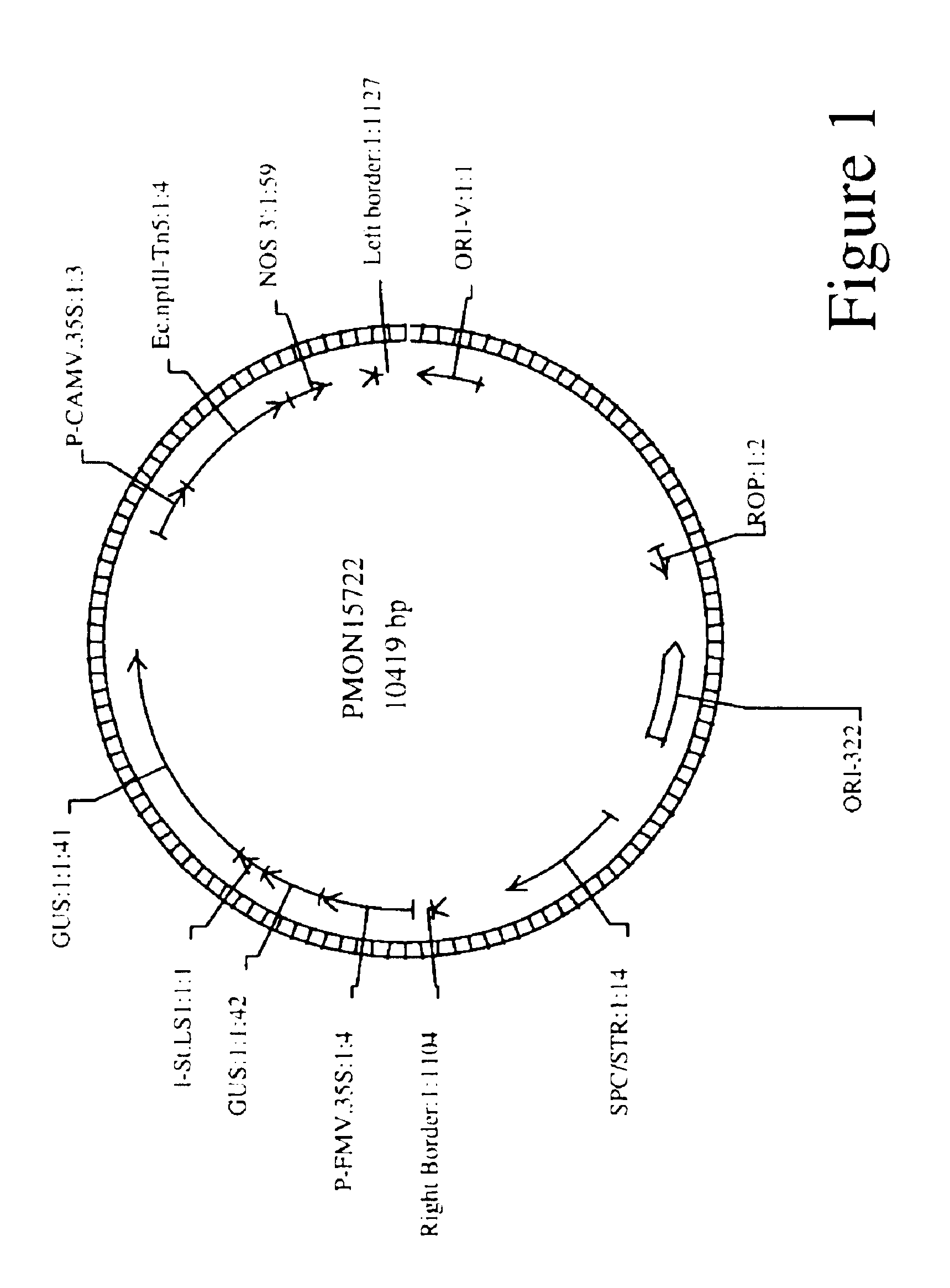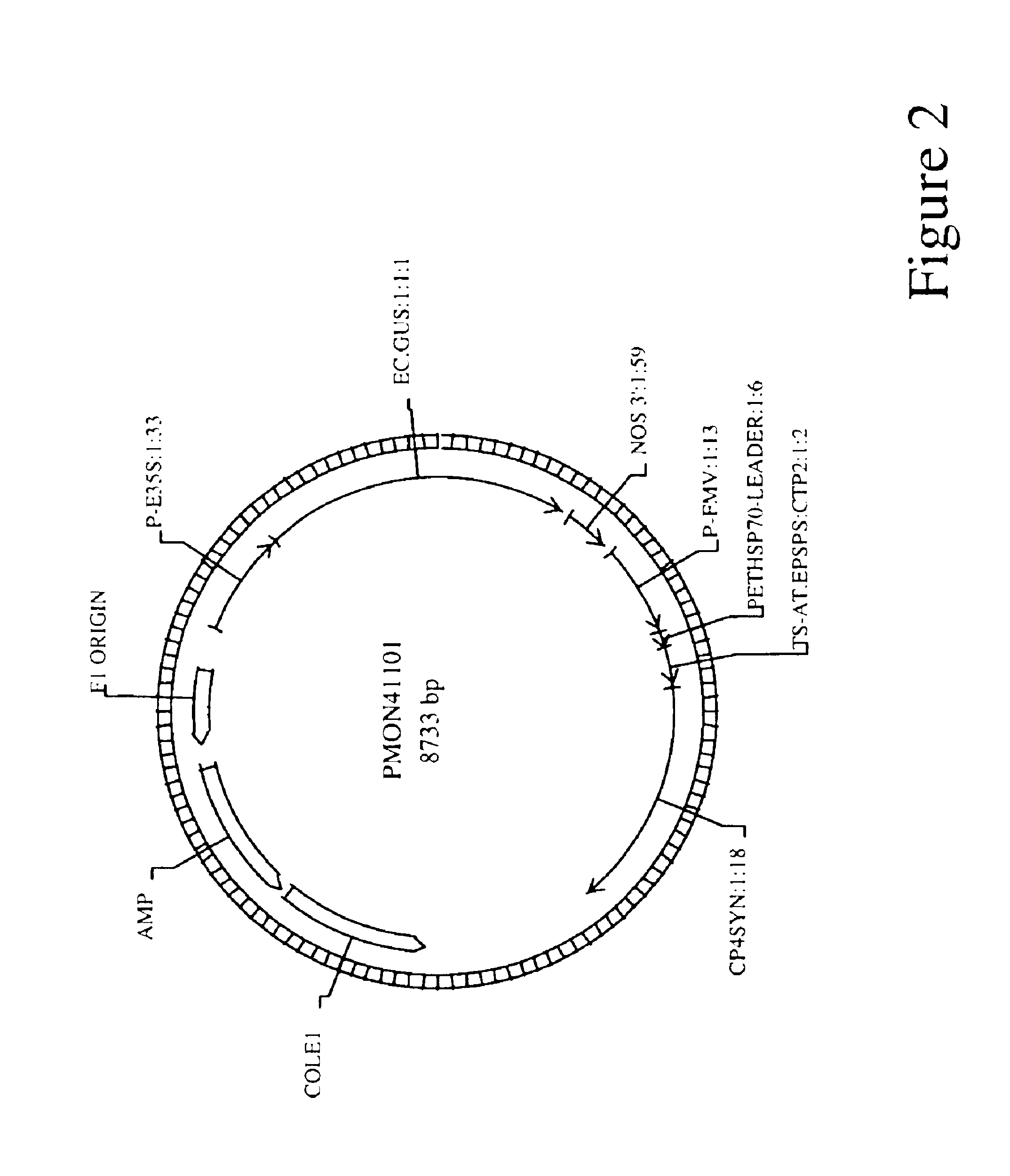Multiple shoot proliferation and regeneration system for plants
a plant and multi-shot technology, applied in the field of plant regeneration, can solve the problems of high rate of plant recovery not being fertile, and current system being very time-consuming and laborious, so as to improve the efficiency of whole cotton plant regeneration, improve the efficiency of production, and meet the production needs
- Summary
- Abstract
- Description
- Claims
- Application Information
AI Technical Summary
Benefits of technology
Problems solved by technology
Method used
Image
Examples
example 1
[0077]Cotton zygotic embryo culture: Untreated delinted, dry cotton seeds were sterilized in freshly made 50% Chlorox plus 2 drops of Tween 20 per 2 liters. Seeds were sterilized for 9-10 minutes. Seeds were rinsed 3 times with sterile distilled water; on the second rinse, the seeds were allowed to soak for 5 minutes prior to removing the water. Seeds were aseptically transferred to sterile 1 liter beakers and equally distributed into 2 beakers. Approximately 600 mL of Cotton Sterilization Medium (CSM) was added to each beaker containing decontaminated seeds. CSM contains carbenicillin (200 mg / L), cefotaxime (250 mg / L) and 6 mL of fungicide stock (1 g benlate, 1 g captan, and 1 g daconil in 100 mL of sterile distilled water) in sterile distilled water.
[0078]Each beaker was covered with sterile aluminum foil and placed in the dark at room temperature for overnight imbibition. The next day, CSM was removed and seeds were transferred to sterile petri dishes, which were placed in a cove...
example 2
[0081]Bacterial preparation: Agrobacterium cultures were prepared as known in the art (Maniatis et al. 1982. Molecular Cloning: A Laboratory Manual, Cold Spring Harbor Press). Specifically, disarmed Agrobacteria containing binary vector(s) are streaked from freezer onto LBSCK plates (contains LB medium plus 1.0 mL of spectinomycin, 0.5 mL of chloramphenicol, 0.5 mL of kanamycin per 500 mL of medium). (Spectinomycin stock=100 mg / mL; chloramphenicol stock =25 mg / mL; kanamycin stock=50 mg / mL.) Bacteria can be incubated at room temperature or in an incubator at 27° C.; bacterial colonies should be seen within 2-4 days. Bacterial should be streaked from freezer every 3-4 weeks. Streak a fresh plate from the freeze plate 2-3 days prior to experimental setup. One to two days prior to the inoculation of the explants, transfer 1 colony of bacteria from a freshly streaked plate to a culture tube containing 5 mL of YEP medium. YEP medium contains the following: 10 g / L peptone, 10 g / L yeast ext...
example 3
[0082]Transformation: Zygotic embryos from cotton cultivar DP50 were prepared as described in Example 1. Embryos were then not wounded, wounded with magnetic particles pulled within a magnetic field, wounded by vacuum infiltration, cut with a scalpel, poked with a needle, or desiccated.
[0083]Desiccation wounding is done by placing the embryos on a Whatman #1 filter paper in a petri dish. The dishes are then left in the flowing air of a horizontal sterile laminar air hood for 30 minutes to 1 hour. The embryos are then removed from the dry filter paper and placed directly into another petri dish containing an Agrobacterium suspension prepared as described in Example 2 for inoculation. After inoculating for 30 minutes, the embryos were co-cultured for 2-7 days.
[0084]Magnet-assisted wounding involves using magnetic metal particles and a magnet to produce microwounds in the tissue. The embryos were placed on a stiff medium of Xanthan Gum to firmly hold the explants in a vertical position...
PUM
| Property | Measurement | Unit |
|---|---|---|
| concentration | aaaaa | aaaaa |
| concentration | aaaaa | aaaaa |
| temperature | aaaaa | aaaaa |
Abstract
Description
Claims
Application Information
 Login to View More
Login to View More - R&D
- Intellectual Property
- Life Sciences
- Materials
- Tech Scout
- Unparalleled Data Quality
- Higher Quality Content
- 60% Fewer Hallucinations
Browse by: Latest US Patents, China's latest patents, Technical Efficacy Thesaurus, Application Domain, Technology Topic, Popular Technical Reports.
© 2025 PatSnap. All rights reserved.Legal|Privacy policy|Modern Slavery Act Transparency Statement|Sitemap|About US| Contact US: help@patsnap.com


